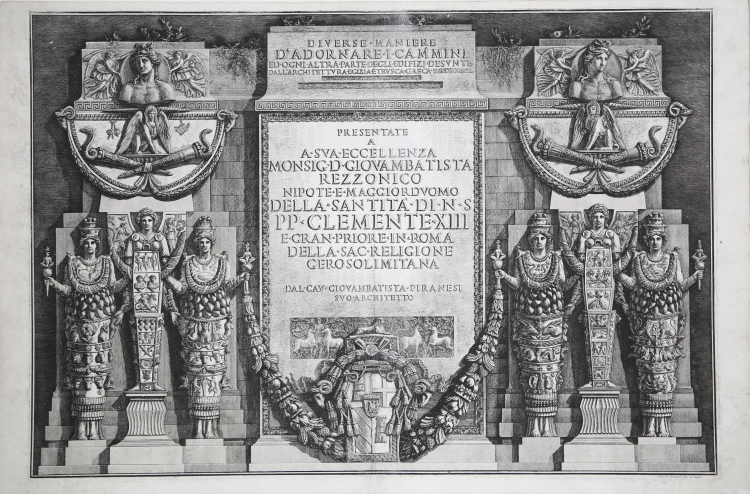




| Reference: | S7825 |
| Author | Giovan Battista PIRANESI |
| Year: | 1769 |
| Measures: | 710 x 480 mm |



| Reference: | S7825 |
| Author | Giovan Battista PIRANESI |
| Year: | 1769 |
| Measures: | 710 x 480 mm |
Etching and engraving, signed at lower right. A very fine impression on contemporary laid paper, with “double circle and fleur-de-lis with letters CB" (Robinson 37), with margins, generally in very good conditions. Diverse Maniere d’adornare i Cammini ed ogni altra parte degli edifizi.. This volume was published in 1769, although a number of letters suggest that work on it had begun a few years before and that, probably, a large number of plates were ready by 1767. From a stylistic point of view, it can undoubtedly be considered as the zenith of Piranesi's inspiration. However, it defies classification; neither baroque nor neo-classical or mannerist, it is, as Focillon simply put it "in Piranesi's style". The novelty embodied in the sixty plates which make up the volume, apart from the intrinsic beauty of the engravings, consists in their spell-binding imagination, their straightforwardness and in an intertwining of classical yearnings and baroque remembrances, being nearly conscious of setting foot into the entranced dreams of an archaeologist. When depicting fireplaces, pieces of furniture, clocks or any other object, Piranesi utilised different decorative themes, which can be broadly divided into two groups. The first one consisted of motifs derived from classical antiquity, especially from Ancient Egypt, while the second theme was inspired by nature, with particular emphasis on elements of the fauna. Piranesi's ideas appear to be disquieting, ambiguous and contradictory, possibly leading toward Romanticism, thus confirming the theory held by a number of scholars who consider him a forerunner of the literary style of the Empire rather than as the foremost exponent of neo-classicism.
|
Focillon 854, Wilton Ely 815
|
Giovan Battista PIRANESI (Mogliano Veneto 1720 - Roma 1778)
|
Italian etcher, engraver, designer, architect, archaeologist and theorist. He is considered one of the supreme exponents of topographical engraving, but his lifelong preoccupation with architecture was fundamental to his art. Although few of his architectural designs were executed, he had a seminal influence on European Neo-classicism through personal contacts with architects, patrons and visiting artists in Rome over the course of nearly four decades. His prolific output of etched plates, which combined remarkable flights of imagination with a strongly practical understanding of ancient Roman technology, fostered a new and lasting perception of antiquity. He was also a designer of festival structures and stage sets, interior decoration and furniture, as well as a restorer of antiquities. The interaction of this rare combination of activities led him to highly original concepts of design, which were advocated in a body of influential theoretical writings. The ultimate legacy of his unique vision of Roman civilization was an imaginative interpretation and re-creation of the past, which inspired writers and poets as much as artists and designers.
|
|
Focillon 854, Wilton Ely 815
|
Giovan Battista PIRANESI (Mogliano Veneto 1720 - Roma 1778)
|
Italian etcher, engraver, designer, architect, archaeologist and theorist. He is considered one of the supreme exponents of topographical engraving, but his lifelong preoccupation with architecture was fundamental to his art. Although few of his architectural designs were executed, he had a seminal influence on European Neo-classicism through personal contacts with architects, patrons and visiting artists in Rome over the course of nearly four decades. His prolific output of etched plates, which combined remarkable flights of imagination with a strongly practical understanding of ancient Roman technology, fostered a new and lasting perception of antiquity. He was also a designer of festival structures and stage sets, interior decoration and furniture, as well as a restorer of antiquities. The interaction of this rare combination of activities led him to highly original concepts of design, which were advocated in a body of influential theoretical writings. The ultimate legacy of his unique vision of Roman civilization was an imaginative interpretation and re-creation of the past, which inspired writers and poets as much as artists and designers.
|